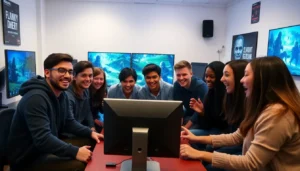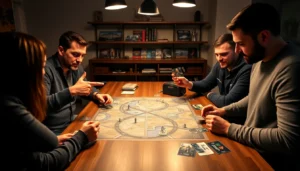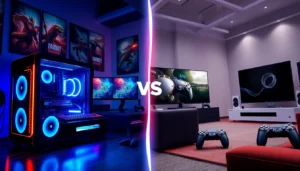Table of Contents
ToggleGhost horror games have a unique way of creeping into players’ hearts—and not just because they’re packed with spine-chilling scares. These games blend suspense, mystery, and a dash of supernatural thrill, creating an experience that keeps players on the edge of their seats. Imagine exploring haunted mansions or navigating eerie forests where every shadow could be hiding a ghostly surprise.
For those who love a good scare, ghost horror games offer an irresistible invitation to confront their fears. Whether it’s the thrill of a ghostly encounter or the challenge of solving paranormal puzzles, these games deliver an adrenaline rush like no other. So grab your flashlight and prepare to dive into a world where the unknown lurks around every corner. After all, who wouldn’t want to get spooked while sitting comfortably on their couch?
Overview of Ghost Horror Games
Ghost horror games immerse players in chilling narratives filled with suspense, mystery, and supernatural occurrences. Various titles in this genre allow exploration of haunted environments, featuring eerie atmospheres that enhance the thrill. Locations often include abandoned houses, dark forests, and forgotten towns, each setting designed to evoke fear and adrenaline.
Players frequently encounter ghostly apparitions that contribute to the game’s fear factor. These spectral beings vary in design and behavior, from menacing shadows to tragic figures tied to the game’s storyline. Storylines often revolve around uncovering secrets, piecing together histories, or solving puzzles connected to the ghosts’ pasts.
Mechanics in ghost horror games focus heavily on immersion. Players may use tools like flashlights, cameras, or other devices to investigate. Response to the game’s environments can lead to palpable tension, as players never know when a ghost may appear or what might happen next.
Multiplayer elements appear in some ghost horror games, allowing shared fright. Collaborating with friends can amplify the experience, adding to the emotional depth and real-time reactions during ghost encounters. Interactive features often enhance the storytelling, making players feel part of the unfolding drama.
Ghost horror games attract a dedicated audience due to their unique blend of fear and intrigue. Engaging narratives challenge players to confront their fears, all from the safety of their own spaces. The genre emphasizes experience over traditional gameplay, offering something distinct in the vast landscape of video games. With numerous options available, each game provides a different take on ghostly fears, appealing to various tastes and preferences.
Popular Ghost Horror Games
Ghost horror games captivate players with their chilling narratives and eerie atmospheres. Below are three standout titles that define the genre.
Game 1: Phasmophobia
Phasmophobia immerses players in a cooperative multiplayer experience, where they become ghost hunters. Players explore haunted locations using tools like EMF readers and spirit boxes. This title features a range of ghost types, each with unique behaviors. As players gather evidence, the tension escalates, enhancing the thrilling experience.
Game 2: Layers of Fear
Layers of Fear presents a psychological horror experience that blends storytelling with exploration. Set in a once grand mansion, players uncover secrets of a tormented artist. This game features stunning visuals and dynamic environments that shift based on player decisions. Players navigate the protagonist’s descent into madness, faced with ghostly manifestations that provoke fear and intrigue.
Game 3: The Haunting of Billy
The Haunting of Billy provides a unique twist on classic ghost stories. This single-player adventure focuses on uncovering the mystery of a haunted house. Players engage in puzzle-solving while evading supernatural threats. Engaging dialogues and immersive sound design amplify the sense of dread. Each choice impacts the narrative, leading to multiple endings that enhance replayability.
Elements That Enhance Fear
Atmospheric design and sound effects play critical roles in enhancing fear in ghost horror games. These elements work together to create an immersive experience for players.
Atmospheric Design
Atmospheric design focuses on creating an unsettling environment. Dim lighting and shadowy corners establish a sense of dread. Characters often navigate through eerie locations like abandoned houses or dark forests. Visual cues like flickering lights or subtle movement in the background keep players on edge. Key details, such as weather effects and realistic textures, amplify immersion. The overall art direction contributes to an uncanny feeling, making each exploration hauntingly memorable. Many games leverage atmospheric elements to evoke emotions, making players feel vulnerable in every step they take.
Sound Effects
Sound effects significantly enhance the horror experience by manipulating player emotions. Ambient noises, such as creaking floorboards or distant whispers, generate tension. Sudden loud noises can provoke instinctive reactions, increasing the overall fear factor. Ghostly moans or unsettling soundtracks create an unsettling backdrop during gameplay. Players often find themselves straining to hear subtle sounds, as they can signal impending danger. Designers use silence strategically to build anticipation, making even the slightest sound feel terrifying. Each sound serves to immerse players deeper into the chilling narratives that define ghost horror games.
Ghost Horror Games vs. Other Horror Genres
Ghost horror games stand out from other horror genres due to their unique emphasis on supernatural elements, suspense, and mystery. Unlike traditional slasher games, ghost horror titles highlight ghostly encounters that create a chilling atmosphere for players. Players engage in immersive narratives where they’re often tasked with unraveling the history and secrets of the haunting, which adds depth to the fright they experience.
In comparison, survival horror games may focus more on resource management and physical threats, requiring players to scavenge for supplies. Ghost horror games shift that focus to psychological tension and the unknown. Manipulating player emotions through atmospheric design and sound effects proves more significant in this genre, creating an unsettling environment that enhances fear.
Additionally, multiplayer ghost horror games like “Phasmophobia” invite cooperative play, intensifying the thrill as friends face spectral threats together. Other horror genres often lack this communal aspect, leaving players to confront their fears individually. Puzzle-solving features in titles such as “The Haunting of Billy” encourage players to think critically while navigating supernatural challenges, setting these games apart.
Visual storytelling remains essential in ghost horror games. Elements such as flickering lights and shadowy corners are designed to evoke anxiety, while other horror genres may rely heavily on gore and jump scares. Engaging soundscapes play a crucial role, shifting attention to ambient noises that heighten tension, unlike sound design in action horror titles that may focus on explosive sequences.
As the genre matures, innovations like virtual reality are reshaping experiences, further distinguishing ghost horror games from their peers. Players find themselves enveloped in haunting atmospheres, pushing boundaries and enhancing emotional engagement.
Future Trends in Ghost Horror Games
Innovations in technology continue to shape the future of ghost horror games. Virtual reality is gaining traction, offering players an immersive experience that enhances engagement with haunting environments. This advancement allows individuals to explore ghostly realms in a way that feels remarkably real.
Developers are increasingly incorporating AI-driven mechanics, allowing ghosts to react uniquely based on player behavior. Enhanced narratives will likely become more interactive, offering choices that affect story outcomes. Players might navigate multiple endings, giving their gameplay a personal touch that deepens emotional connections.
Multiplayer features will evolve as well, promoting collaboration among players to solve puzzles and uncover mysteries. As players work together, shared fears and victories create memorable moments. Communities around these games may grow stronger, as players exchange experiences and strategies.
Cross-platform play is also becoming a standard expectation, allowing friends across different systems to enjoy ghost horror games together. Accessibility ensures that a broader audience can experience the thrill of ghost hunting.
Graphics technology advances promise even more realistic visual effects and atmospheric design. Games may showcase lifelike ghostly apparitions and eerily detailed environments, pulling players deeper into the narrative.
Additionally, sound design is set to become increasingly sophisticated. The future may include spatial audio that enhances immersion, making players feel surrounded by unsettling sounds. This can amplify tension, leading to heightened player experiences.
The future of ghost horror games holds exciting developments that promise to deepen immersion, emotional engagement, and the overall thrill of confronting the supernatural.
Ghost horror games offer a unique blend of suspense and supernatural intrigue that captivates players. With their immersive environments and chilling narratives, these games challenge players to confront their fears in a safe yet thrilling way. The innovative use of technology continues to enhance the genre, promising even more engaging experiences in the future.
As developers push boundaries with advancements like virtual reality and AI-driven mechanics, the excitement surrounding ghost horror games is only set to grow. Whether playing solo or with friends, these chilling adventures provide unforgettable encounters that keep players coming back for more. Embracing the unknown has never been so enticing.




